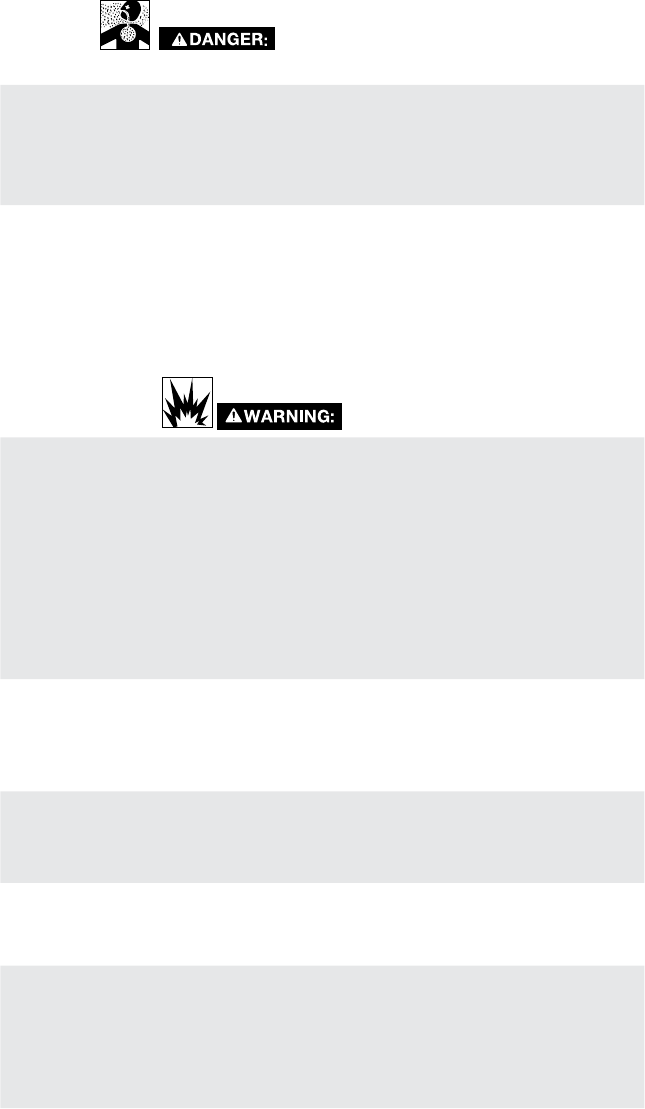
2 3
RISK TO BREATHING (ASPHYXIATION)
WHAT CAN HAPPEN HOW TO PREVENT IT
• The compressed air directly from your
compressor is not safe for breathing. The
air stream may contain carbon monoxide,
toxic vapors, or solid particles from the air
tank. Breathing these contaminants can
cause serious injury or death.
• Neveruseairobtaineddirectlyfrom
the compressor to supply air for human
consumption. The compressor is not
equipped with suitable filters and in-line
safety equipment for human consumption.
• Exposuretochemicalsindustcreatedby
power sanding, sawing, grinding, drilling,
and other construction activities may be
harmful.
• Sprayedmaterialssuchaspaint,paint
solvents, paint remover, insecticides,
weed killers, may contain harmful vapors
and poisons.
• Workinanareawithgoodcross
ventilation. Read and follow the safety
instructions provided on the label or
safety data sheets for the materials you
are spraying. Always use certified safety
equipment:NIOSH/OSHArespiratory
protection or properly fit ting face mask
designed for use with your specific
application.
RISK OF BURSTING
Air Tank: OnFebruary26,2002,theU.S.ConsumerProductSafetyCommissionpublished
Release # 02-108 concerning air compressor tank safety:
Air compressor receiver tanks do not have an infinite life. Tank life is dependent upon several
factors, some of which include operating conditions, ambient conditions, proper installations,
field modifications, and the level of maintenance. The exact effect of these factors on air
receiver life is difficult to predict.
If proper maintenance procedures are not followed, internal corrosion to the inner wall of the
air receiver tank can cause the air tank to unexpectedly rupture allowing pressurized air to
suddenly and forcefully escape, posing risk of injury to consumers.
Your compressor air tank must be removed from service by the end of the year shown on your
tank warning label.
The following conditions could lead to a weakening of the air tank, and result in a violent air
tank explosion:
WHAT CAN HAPPEN HOW TO PREVENT IT
• Failuretoproperlydraincondensedwater
from air tank, causing rust and thinning of
the steel air tank.
• Drainairtankdailyoraftereachuse.
If air tank develops a leak, replace it
immediately with a new air tank or
replace the entire compressor.
• Modificationsorattemptedrepairsto
the air tank.
• Neverdrillinto,weld,ormakeany
modifications to the air tank or its
attachments.Neverattempttorepaira
damaged or leaking air tank.
Replace with a new air tank.
• UnauthorizedmodificationstotheSafety
Valve (G) or any other components which
control air tank pressure.
• Theairtankisdesignedtowithstand
specificoperatingpressures.Nevermake
adjustments or parts substitutions to alter
the factory set operating pressures.
Attachments & accessories:
• Exceedingthepressureratingofairtools,
spray guns, air operated accessories,
tires, and other inflatables can cause
them to explode or fly apart, and could
result in serious injury.
• Followtheequipmentmanufacturers
recommendation and never exceed the
maximum allowable pressure rating of
attachments.Neverusecompressorto
inflate small low pressure objects such as
children’s toys, footballs, basketballs, etc.


















